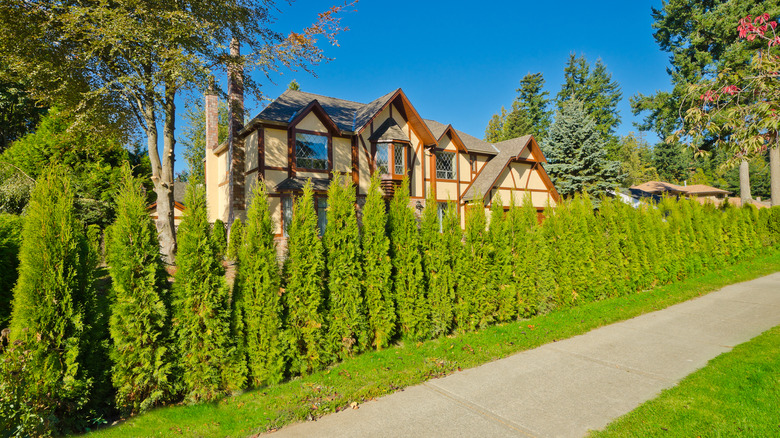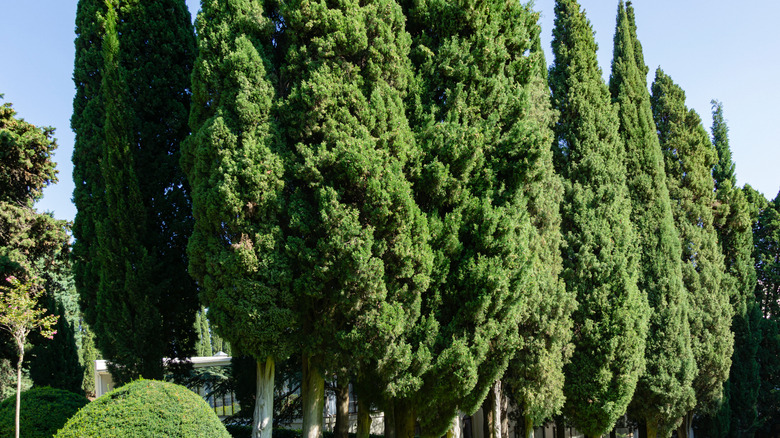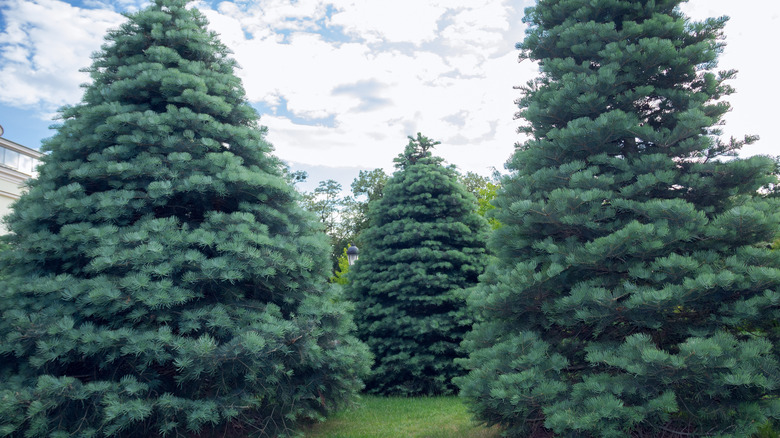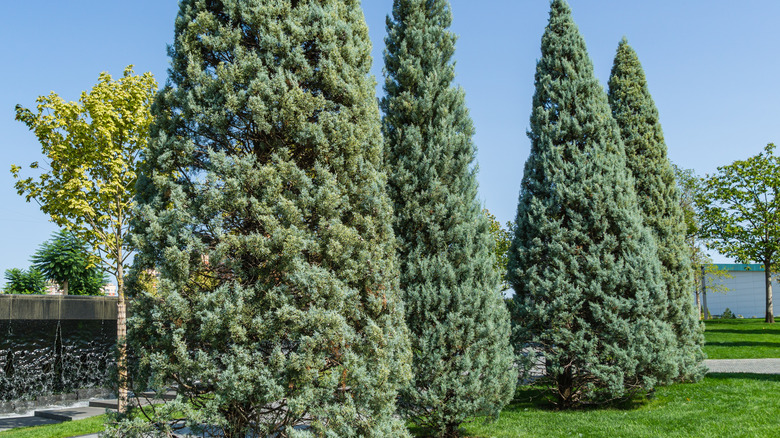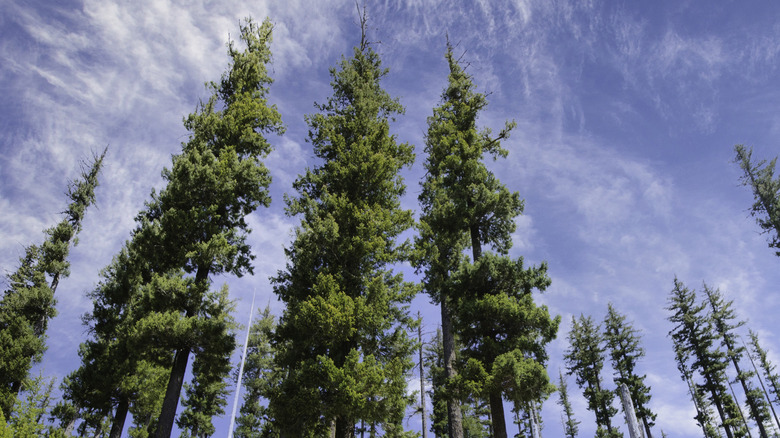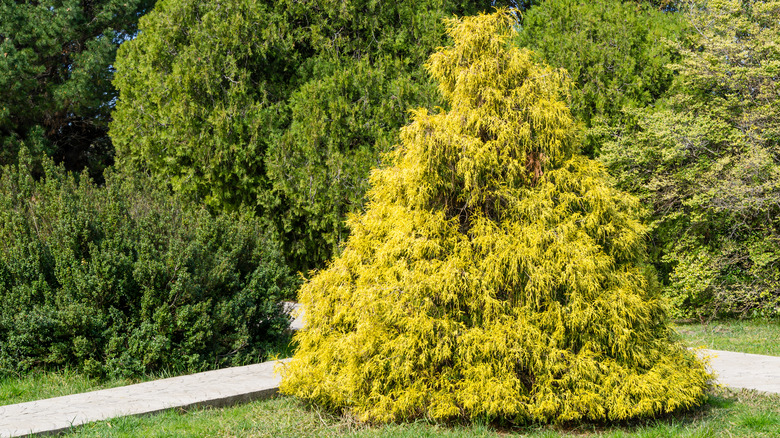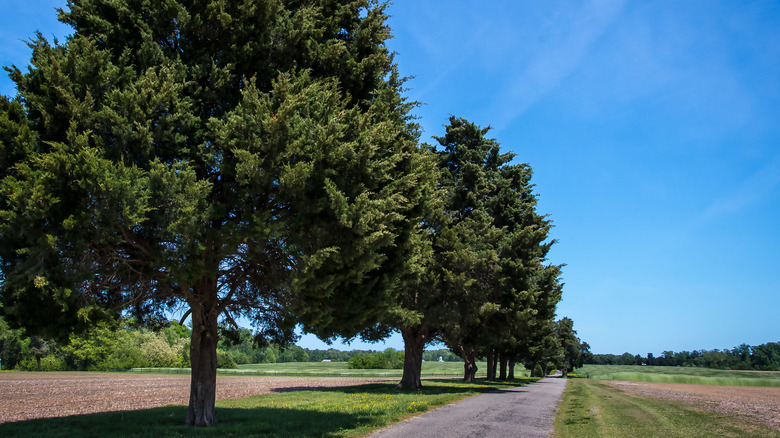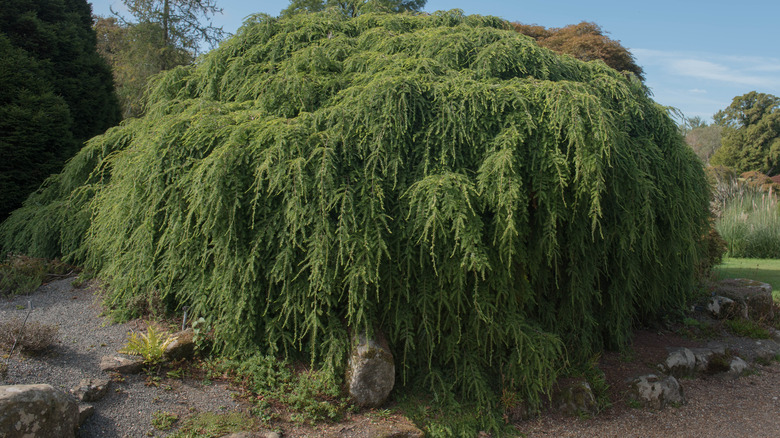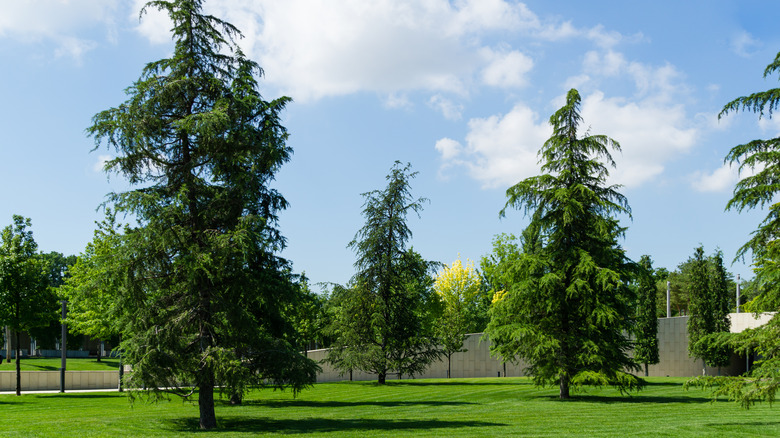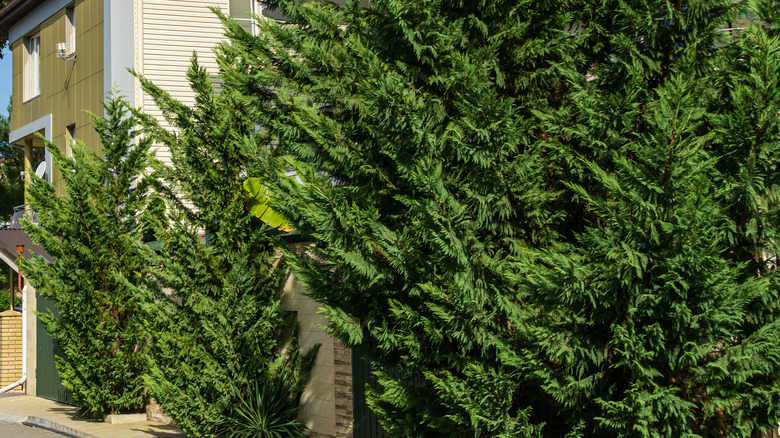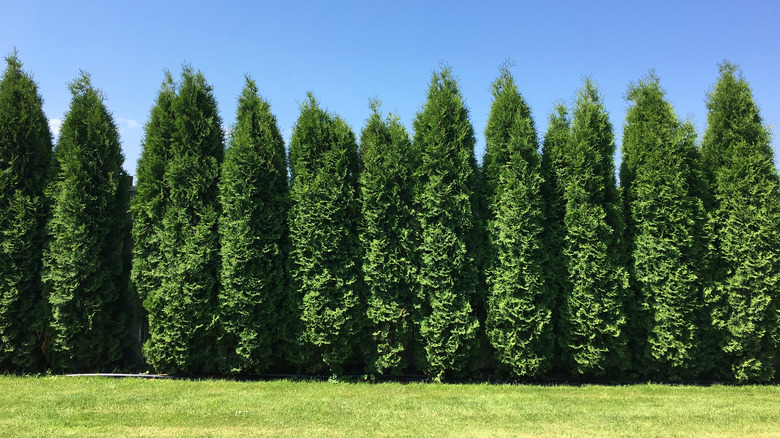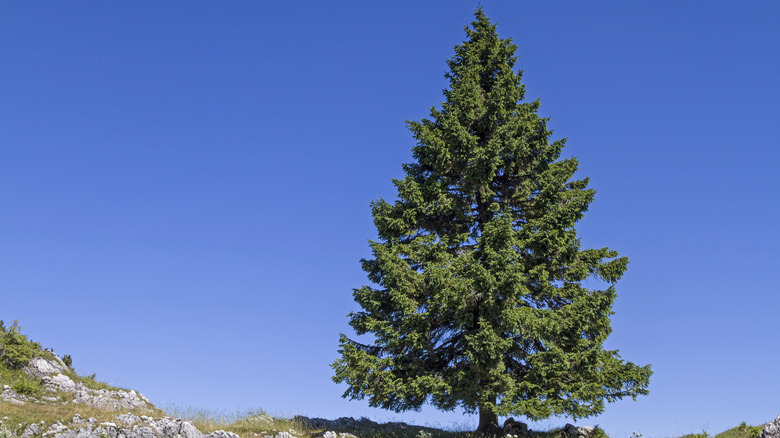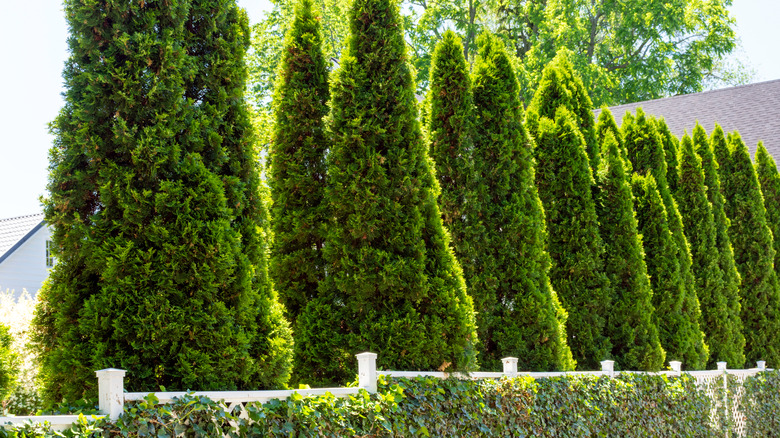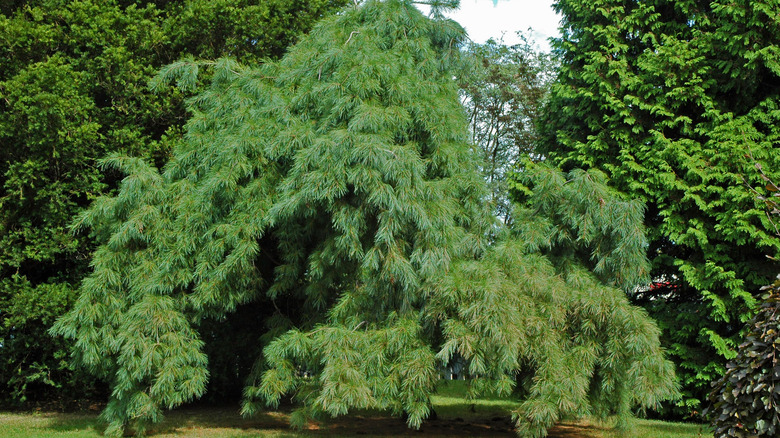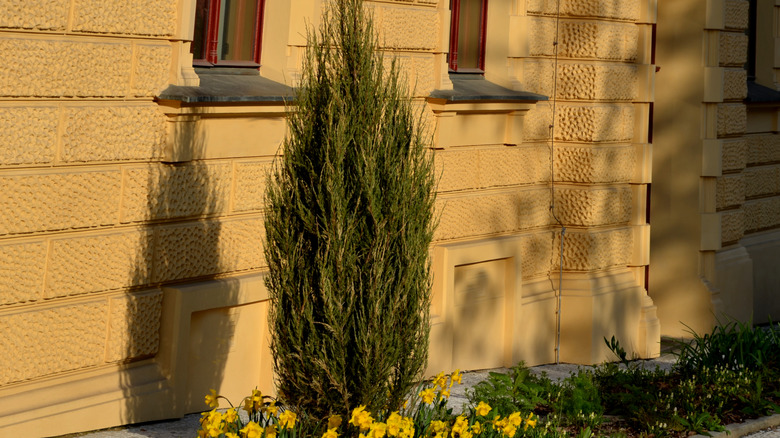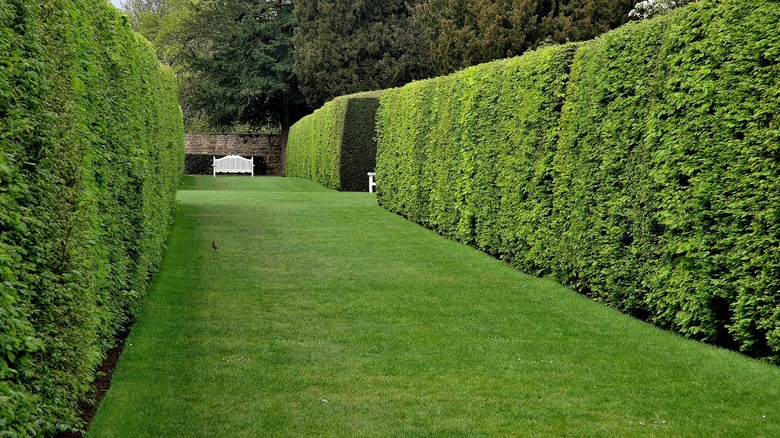15 Evergreen Trees That Give You Privacy All Year Round
Trees are perfect natural options for privacy, but many lose their foliage in winter. To that end, if you want to keep your solitude all year round, then evergreens are the way to go. Besides their concealing nature, there are many advantages for growing them. For starters, they enhance the natural beauty of the landscape. They also provide shade, which means relief from the sun's heat if they are close to your home. Evergreens even provide a nice sound barrier, and they help break wind. They are hardy as well, growing on every continent of the earth except Antarctica, per Gardening Guides.
If you are thinking about adding an evergreen or two to your real estate, there are dozens of varieties to choose from; while some can reach towering heights, there are smaller types of evergreens for yards with limited space. We have searched the internet and found 15 evergreens that provide privacy while looking absolutely gorgeous.
1. Italian Cypress
If you are looking for an evergreen that grows quickly, then you might want to consider growing an Italian Cypress (Cupressus sempervirens). These trees are easily identifiable by their slim, pyramid shape, which makes them perfect for lining a path or driveway. They are easy to care for and can tolerate a variety of soil types as well as dry seasons, according to the University of Redlands.
USDA Growing Zone: 7 through 11
Growing Conditions: bright, indirect light
Soil Type: well-draining
Size: up to 60 feet
2. Concolor Fir
Naturally asymmetrical in shape, Concolor Fir (Abies concolor) trees make lovely privacy fences with their bluish needles. While they can tolerate a range of temperatures, they have a difficult time in humid conditions. They also do not do well in heavily polluted areas, per Gardening Know How. Versatile, these trees can adapt to different amounts of sunlight. When pruning, be careful to follow their natural shape to keep them visually stunning.
USDA Growing Zone: 3 through 8
Growing Conditions: full sun to partial shade
Soil Type: well-draining
Size: up to 130 feet tall
3. Sapphire Cypress
As the name suggests, Sapphire Cypress (Cupressus arizonica) trees have a blue-green foliage. Sometimes used for Christmas trees, they are excellent to use for solitude because they grow quickly. Most do not exceed more than 12 feet in diameter and the average height is about 30 feet tall, according to Washington State University.
USDA Growing Zone: 7 through 9
Growing Conditions: full sun
Soil Type: moist
Size: up to 45 feet tall
4. Douglas Fir
There are two types of Douglas Firs (Pseudotsuga menziesii) — the coastal version and the Rocky mountain variety. The coastal Douglas Firs are taller and grow quicker than the Rocky Mountain variety, and they both will provide lovely greenery all year, according to Gardening Know How. Once the tree is settled, it will require minimum care.
USDA Growing Zone: 4 through 6
Growing Conditions: part to full shade
Soil Type: moist and well draining
Size: up to 120 feet tall
5. False Cypress
You will find many varieties of False Cypress (Chamaecyparis pisifera) trees available. They range in heights, so you have choices if you have a smaller area to work with. False Cypress trees are easy to maintain once they become well-rooted, and they can also tolerate a variety of temperatures, as noted by The Spruce.
USDA Growing Zone: 4
Growing Conditions: full sun to partial shade
Soil Type: moist, well draining
Size: different varieties range from 6 to 25 feet tall
6. Eastern Red Cedar
Eastern Red Cedars (Juniperus virginiana) are one of the best drought-resistant conifers in the U.S., according to North Carolina State Extension. These trees need plenty of space to spread out. Keep in mind the oils from Eastern Red Cedar trees are slightly toxic and may cause diarrhea if consumed in large quantities.
USDA Growing Zone: 2 through 9
Growing Conditions: 6 hours of full sun daily
Soil Type: dry to moist, well-drained
Size: up to 40 feet tall
7. Canadian Hemlock
The state tree of Pennsylvania, the Canadian Hemlock or Eastern Hemlock (Tsuga canadensis) is fairly easy to grow in the right conditions. That being said, they prefer cooler temperatures and shade. Hemlocks can fall victim to needle blight and pests such as bagworms, borers, and spider mites, per Missouri Botanical Garden. If you want your Hemlock to do well, keep out of windy areas and hot afternoon sun.
USDA Growing Zone: 3 through 7
Growing Conditions: partial to full shade
Soil Type: moist, well-draining
Size: up to 70 feet
8. Deodar Cedar
Another cedar that can provide your property with plenty of privacy is the Deodar Cedar (Cedrus deodara). These trees have long branches that droop with needles that become golden-green in the summer, as noted by Gardenia. They grow quickly and are relatively easy to care for. Moreover, they don't grow to tall or wide, which makes them ideal for smaller areas.
USDA Growing Zone: 7 through 9
Growing Conditions: sun
Soil Type: dry, well-draining
Size: up to 10 feet
9. Leyland Cypress
Another quick growing evergreen is the Leyland Cypress (Cupressocyparis leylandii). Clemson University notes that they can grow up to 3 feet per year. Like the Italian Cypress, the Leyland Cypress is shaped like a pyramid, but with wider branches, creating more of a classic Christmas tree shape. They can tolerate a variety of soil types as long as they receive proper drainage.
USDA Growing Zone: 6 through 10
Growing Conditions: sun and partial shade
Soil Type: well-draining
Size: up to 70 feet
10. Thuja Green Giant
Another quick-growing evergreen is the Thuja Green Giant (Thuja standishii × plicata). They can grow up to 3 feet per year, and they do well in a variety of soil types. They can also withstand heat, humidity, ice, and drought, according to This Old House. With glossy leaves that don't require much in the form of pruning, they make ideal fences.
USDA Growing Zone: 5 through 9
Growing Conditions: full sun (at least four hours per day) to partial shade
Soil Type: moist
Size: up to 60 feet tall
11. Norway spruce
Tall and majestic, the Norway Spruce (Picea abies) trees prefer cooler temperatures, but they can tolerate many climates as long as they get the sun and water they need. Garden Guides suggests watering your Norway Spruce once a week during warmer temperatures and fertilizing once a month from spring to autumn to keep them looking their best.
USDA Growing Zone: 3 through 7
Growing Conditions: full sun
Soil Type: moist
Size: up to 80 feet tall
12. Emerald Green Thuja
If you like the idea of Green Giants, but are looking for something a bit smaller, the Emerald Green Thuja might make a perfect choice for a privacy barrier. These trees grow to about 12 feet tall, but they can be as short as 2 feet tall if you clip them early. You can even grow them in large containers, per The Tree Center. Emerald Green Thujas grow and become dense quickly, and they are low-maintenance.
USDA Growing Zone: 2 through 7
Growing Conditions: mostly sun, but can tolerate some shade
Soil Type: moist
Size: up to 12 feet tall
13. White Pine
If you live in the eastern U.S., white pines (Pinus strobus) make ideal fences. When planting, avoid low-lying areas or sections of land near bodies of water as these conditions make the trees susceptible to blister rust, according to the Minnesota Department of Natural Resources. White pines do best if planted on the sides of hills or slopes. If you plant them in sunny areas, they will do well but may fall victim to diseases.
USDA Growing Zone: 3 through 8
Growing Conditions: can tolerate up to 50% shade
Soil Type: well-draining soil
Size: up to 150 feet tall
14. Taylor Juniper
Taylor Juniper trees (Juniperus virginiana) grow tall and narrow, averaging only about 5 feet wide. Their size makes them a perfect choice for lining the edge of your property or home for some privacy. Their bluish hue makes them a lovely addition to any yard, and the female trees produce purplish berries that attract birds. Taylor Junipers tolerate most weather conditions and diseases, but they are susceptible to are bagworms and spider mites, per Nebraska Extension.
USDA Growing Zone: 3 through 9
Growing Conditions: full sun
Soil Type: well-draining
Size: 15 to 20 feet tall
15. Yew
Yew trees (Taxus baccata) are actually shrubs, but they are evergreens that can give you privacy all year, per Gardenista. What they lack in height, they make up for in width. These shrubs can grow 20 feet wide, and they can be trimmed to make perfect fences. They are toxic, however, so keep that in mind when planting them. There are many varieties to choose from and most are hardy and can survive most conditions.
USDA Growing Zone: 4 through 7
Growing Conditions: partial shade
Soil Type: well-draining
Size: up to 4 feet tall and 20 feet wide
